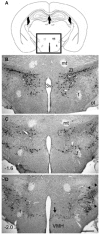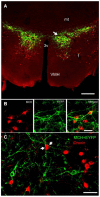Neurons containing orexin or melanin concentrating hormone reciprocally regulate wake and sleep
- PMID: 25620917
- PMCID: PMC4287014
- DOI: 10.3389/fnsys.2014.00244
Neurons containing orexin or melanin concentrating hormone reciprocally regulate wake and sleep
Abstract
Neurons containing orexin (hypocretin), or melanin concentrating hormone (MCH) are intermingled with each other in the perifornical and lateral hypothalamus. Each is a separate and distinct neuronal population, but they project to similar target areas in the brain. Orexin has been implicated in regulating arousal since loss of orexin neurons is associated with the sleep disorder narcolepsy. Microinjections of orexin into the brain or optogenetic stimulation of orexin neurons increase waking. Orexin neurons are active in waking and quiescent in sleep, which is consistent with their role in promoting waking. On the other hand, the MCH neurons are quiet in waking but active in sleep, suggesting that they could initiate sleep. Recently, for the first time the MCH neurons were stimulated optogenetically and it increased sleep. Indeed, optogenetic activation of MCH neurons induced sleep in both mice and rats at a circadian time when they should be awake, indicating the powerful effect that MCH neurons have in suppressing the wake-promoting effect of not only orexin but also of all of the other arousal neurotransmitters. Gamma-Aminobutyric acid (GABA) is coexpressed with MCH in the MCH neurons, although MCH is also inhibitory. The inhibitory tone of the MCH neurons is opposite to the excitatory tone of the orexin neurons. We hypothesize that strength in activity of each determines wake vs. sleep.
Keywords: hypothalamus; melanin concentrating hormone; optogenetics; sleep.
Figures



Similar articles
-
Sleep Deprivation Distinctly Alters Glutamate Transporter 1 Apposition and Excitatory Transmission to Orexin and MCH Neurons.J Neurosci. 2018 Mar 7;38(10):2505-2518. doi: 10.1523/JNEUROSCI.2179-17.2018. Epub 2018 Feb 5. J Neurosci. 2018. PMID: 29431649 Free PMC article.
-
Orexin/Hypocretin and MCH Neurons: Cognitive and Motor Roles Beyond Arousal.Front Neurosci. 2021 Mar 22;15:639313. doi: 10.3389/fnins.2021.639313. eCollection 2021. Front Neurosci. 2021. PMID: 33828450 Free PMC article. Review.
-
GABAergic neurons intermingled with orexin and MCH neurons in the lateral hypothalamus discharge maximally during sleep.Eur J Neurosci. 2010 Aug;32(3):448-57. doi: 10.1111/j.1460-9568.2010.07295.x. Epub 2010 Jun 30. Eur J Neurosci. 2010. PMID: 20597977 Free PMC article.
-
VGAT and VGLUT2 expression in MCH and orexin neurons in double transgenic reporter mice.IBRO Rep. 2018 May 12;4:44-49. doi: 10.1016/j.ibror.2018.05.001. eCollection 2018 Jun. IBRO Rep. 2018. PMID: 30155524 Free PMC article.
-
Hypothalamic regulation of the sleep/wake cycle.Neurosci Res. 2017 May;118:74-81. doi: 10.1016/j.neures.2017.03.013. Epub 2017 May 17. Neurosci Res. 2017. PMID: 28526553 Review.
Cited by
-
Sleep-Dependent Structural Synaptic Plasticity of Inhibitory Synapses in the Dendrites of Hypocretin/Orexin Neurons.Mol Neurobiol. 2017 Oct;54(8):6581-6597. doi: 10.1007/s12035-016-0175-x. Epub 2016 Oct 12. Mol Neurobiol. 2017. PMID: 27734337
-
Neural Damage in Experimental Trypanosoma brucei gambiense Infection: Hypothalamic Peptidergic Sleep and Wake-Regulatory Neurons.Front Neuroanat. 2018 Feb 27;12:13. doi: 10.3389/fnana.2018.00013. eCollection 2018. Front Neuroanat. 2018. PMID: 29535612 Free PMC article.
-
Multifaceted actions of melanin-concentrating hormone on mammalian energy homeostasis.Nat Rev Endocrinol. 2021 Dec;17(12):745-755. doi: 10.1038/s41574-021-00559-1. Epub 2021 Oct 4. Nat Rev Endocrinol. 2021. PMID: 34608277 Review.
-
Selective activation of the hypothalamic orexinergic but not melanin-concentrating hormone neurons following pilocarpine-induced seizures in rats.Front Neurosci. 2022 Dec 1;16:1056706. doi: 10.3389/fnins.2022.1056706. eCollection 2022. Front Neurosci. 2022. PMID: 36532270 Free PMC article.
-
Altered sleep intensity upon DBS to hypothalamic sleep-wake centers in rats.Transl Neurosci. 2021 Dec 31;12(1):611-625. doi: 10.1515/tnsci-2020-0202. eCollection 2021 Jan 1. Transl Neurosci. 2021. PMID: 35070444 Free PMC article.
References
Publication types
Grants and funding
LinkOut - more resources
Full Text Sources
Other Literature Sources

